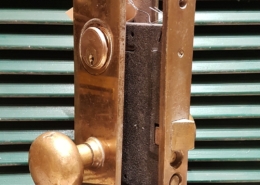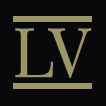



“Art Deco was the first comprehensive American decorative style that originated in France, not in Britain. It was also the first decorative style that looked toward the future rather than the past…Innovations in this period included the use of new materials such as Bakelite, Lucite, aluminum, and stainless steel; the introduction of cylindrical lock sets; and ‘hardware-less’ design…Elegant and sensuous, Art Deco (sometimes called Streamline Moderne) hardware was designed with an eye to the future.”
L. Gordon and T. Hartman
Decorative Hardware – Interior Designing with Knobs, Handles, Latches, Locks, Hinges and Other Hardware.
New York, HarperCollings Publishers Inc., 2000.
“Featuring function over form, the Arts & Crafts style of hardware harkens back to the past. It is simple, stylized, and, in the case of furniture hardware, never used solely for decoration. Hardware was viewed as ‘useful art’.”
“Always looking toward the past, the style is functional, simple, and handmade.”
L. Gordon and T. Hartman
Decorative Hardware – Interior Designing with Knobs, Handles, Latches, Locks, Hinges and Other Hardware.
New York, HarperCollings Publishers Inc., 2000.
“Victorian doorknobs, doorplates, hinges, and furniture pulls are lavish, with complicated, swirling, floral patterns and relief. When describing American decorative hardware, the label “Victorian” specifically signifies a period in time, not a style of hardware, although over time the label has come to signify a variety of styles that were all popular during the period. Today many different styles of decorative arts coexist under this general catchphrase.”
“This era represents the peak of the American decorative hardware industry. The Industrial Revolution and the resulting increased productivity leads to an explosion of choices, schools, patterns, finishes – and consequently the birth of planned obsolescence.”
L. Gordon and T. Hartman
Decorative Hardware – Interior Designing with Knobs, Handles, Latches, Locks, Hinges and Other Hardware.
New York, HarperCollings Publishers Inc., 2000.
“With its strong detailing, Eastlake hardware can become a decorative accent in almost any style of room. It works very well in Victorian settings, and the more geometric Eastlake patterns are very fitting for Art Deco interiors. Asian-inspired rooms are also great backgrounds for Eastlake hardware.”
“Innovations during the period include mass-produced and mass-marketed door hardware, building and furniture hardware with a single stylistic theme. The founding of American hardware’s “big three” – Russel and Erwin, P. & F. Corbin, and Yale and Towne – and the birth of suburbia. The hardware was elaborate, stylized, extravagant, and incised.”
L. Gordon and T. Hartman
Decorative Hardware – Interior Designing with Knobs, Handles, Latches, Locks, Hinges and Other Hardware.
New York, HarperCollings Publishers Inc., 2000.
“By the mid 1860’s the basic rim lock was being made as it would remain for the next century. Companies continued to work on improving the working of the lock mechanisms mainly by removing as many unnecessary parts as possible. The rim lock remained the backbone of the lock industry and is still the hardiest locks ever made.”
Ed Donaldson
Gravity locks use gravity instead of a spring to engage the latch, and usually are ornamented with Victorian details.
Primitive Latches – fortifications universally comprised a repurposed bar placed across the portal and secured at both ends. Designs permitting the bar to slide aside and miniaturization of the device created the ‘slide-bolt’ and enabled this timeless and sometimes decorative locking system to be affixed to the door.
By anchoring one end of the bar whilst allowing it to swivel the bar could be lifted in and out of its keeper. This revelation birthed the first thumb-latch. Blacksmiths created highly imaginative designs- heart, spade, tulip, cannonball, and swordfish to name a few.
1700s – Hundreds of years passed passed until the 18th century. During the reign of George II (1727-1760) a Georgian blacksmith passed a spindle through a door, a plate mounted on the inside of the door, and a cam abutting the plate. To the plate he then attached one end of a latch-bar, with the latch-bar resting on the cam such that turning the knobs on either end of the spindle rotated the spindle, and in turn the cam, thus raising the latch-bar.
This was a EUREKA moment.
1800s – During the ensuing Regency period, in approximately 1820, John Carpenter’s designs enclosed the mechanism in a box. Fast forward fifty years and find that during the mid 19th century the Victorians modified the mechanism’s rotary motion to withdraw, rather than lift the latch… another milestone.
In 1840 the industrial revolution was beginning. It celebrated mass production and heralded the demise of individualized hand wrought hardware. At this point in time the latch was buried (mortised) into the edge of the door.
1900s – Hardware thus became totally reliant on its trimmings for aesthetics. Mass marketing and early consumerism entrenched 20th century style trends like Art Deco, Art Nouveau, Arts and Crafts and a plethora of revival styles.
For more information on hardware, check out our blog post entitled “Three Centuries Of Door Hardware“.